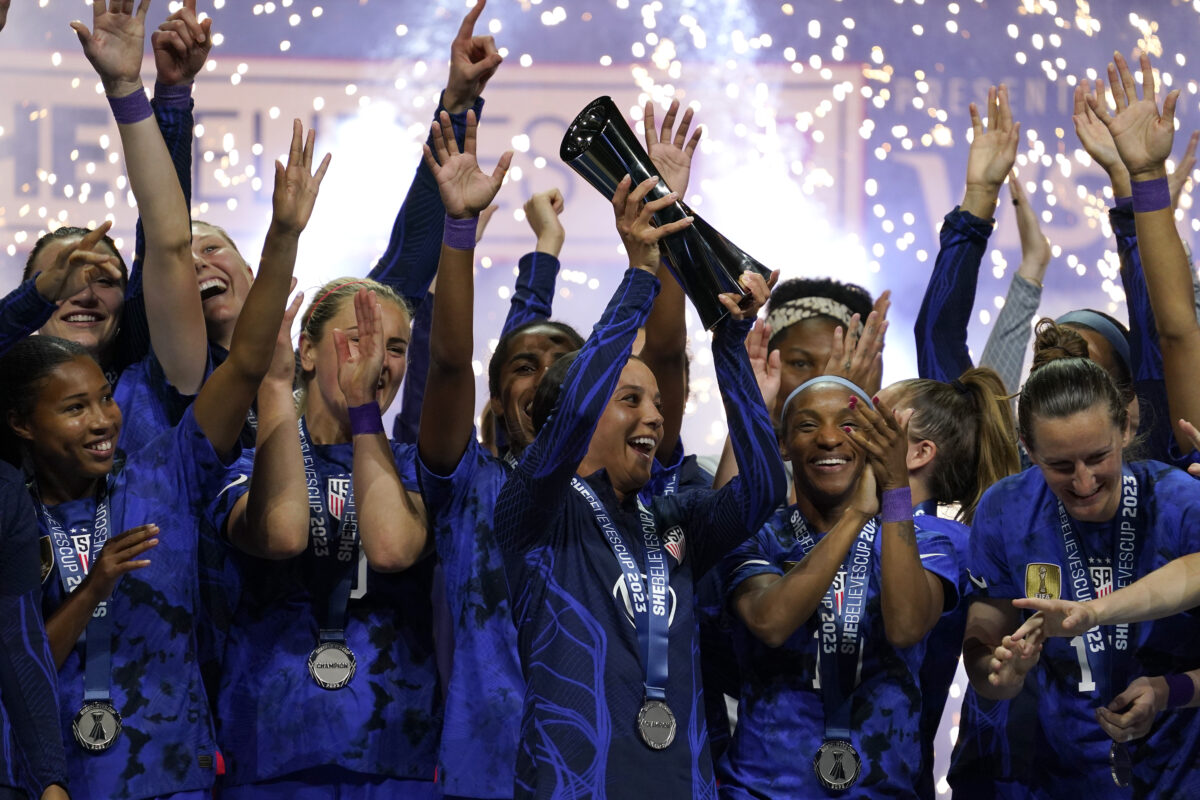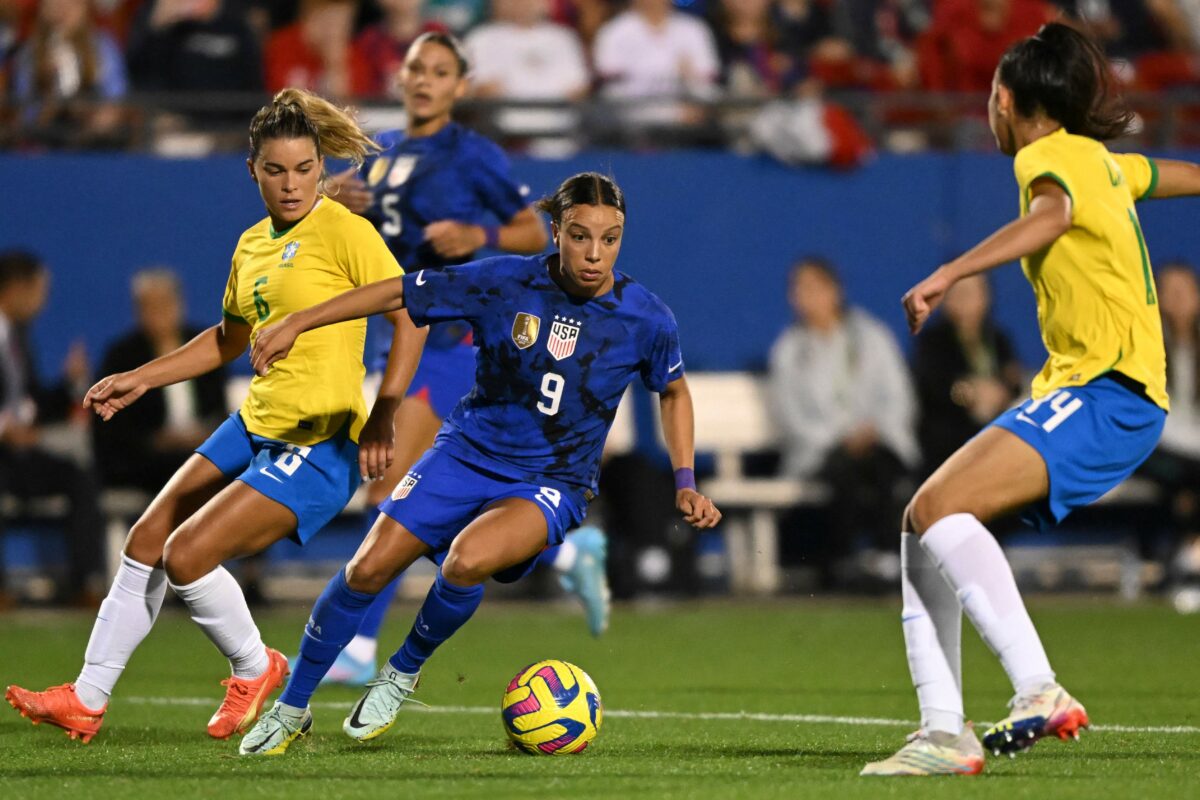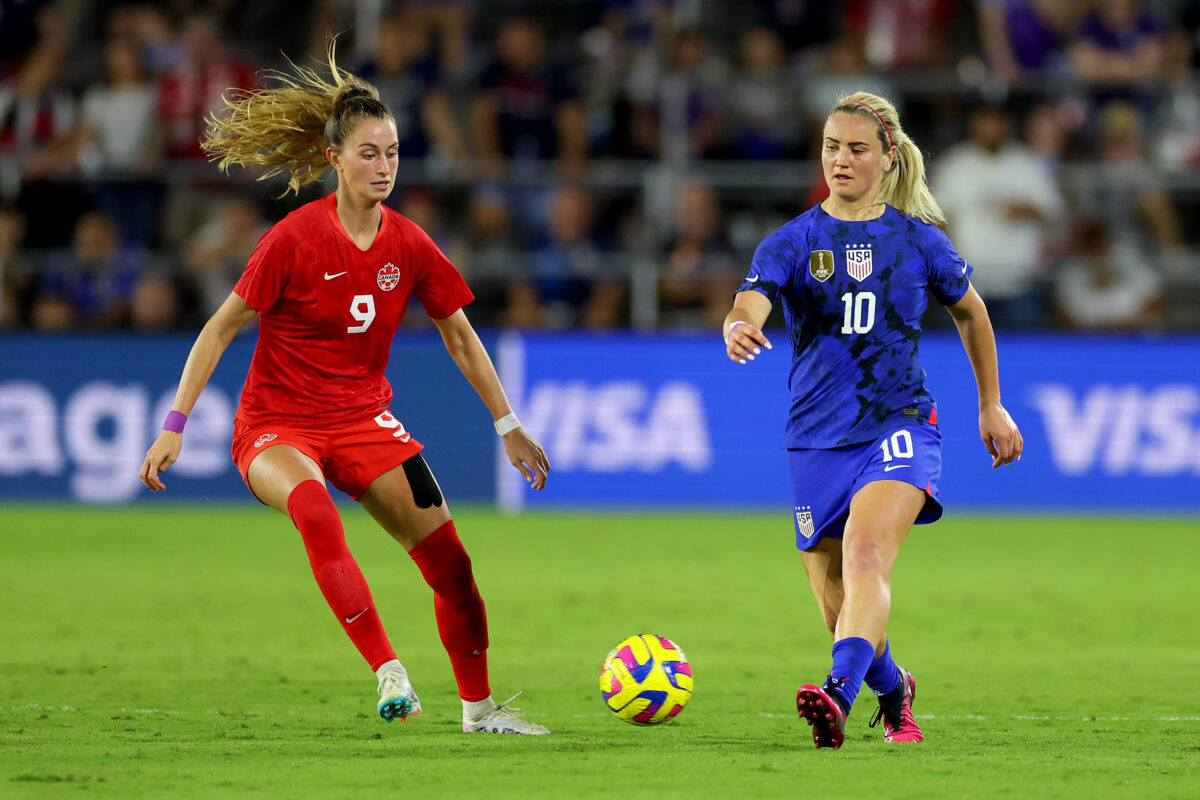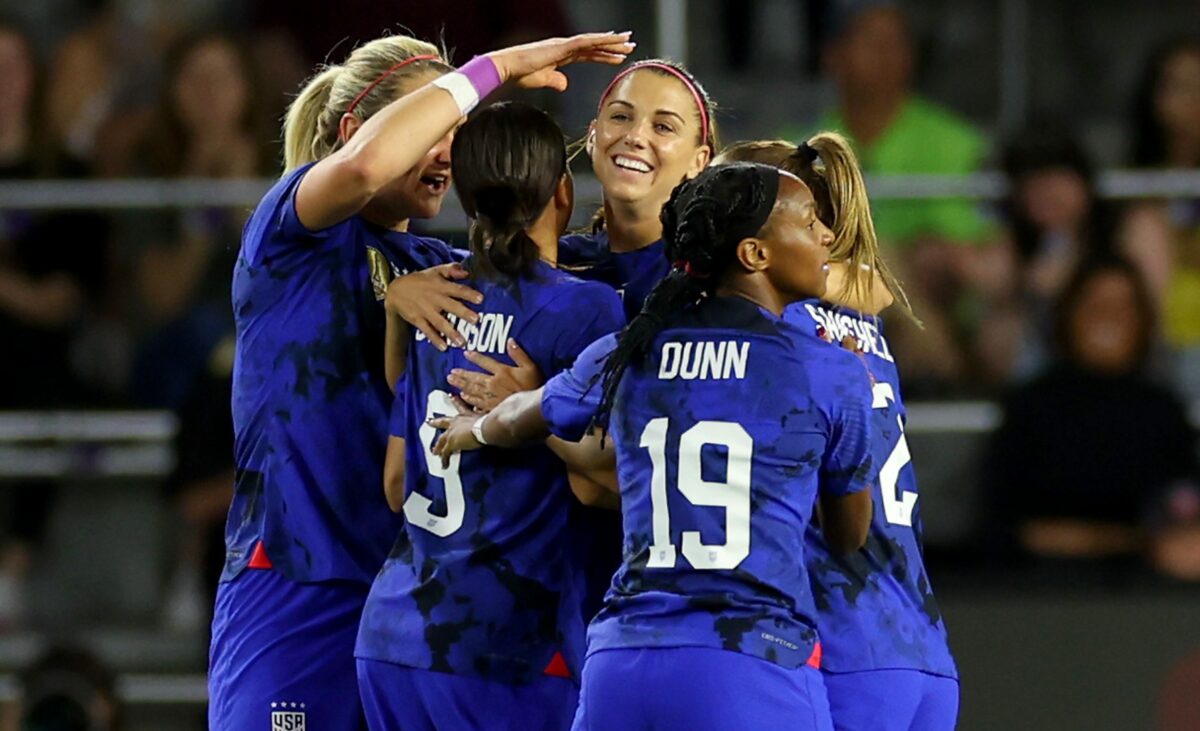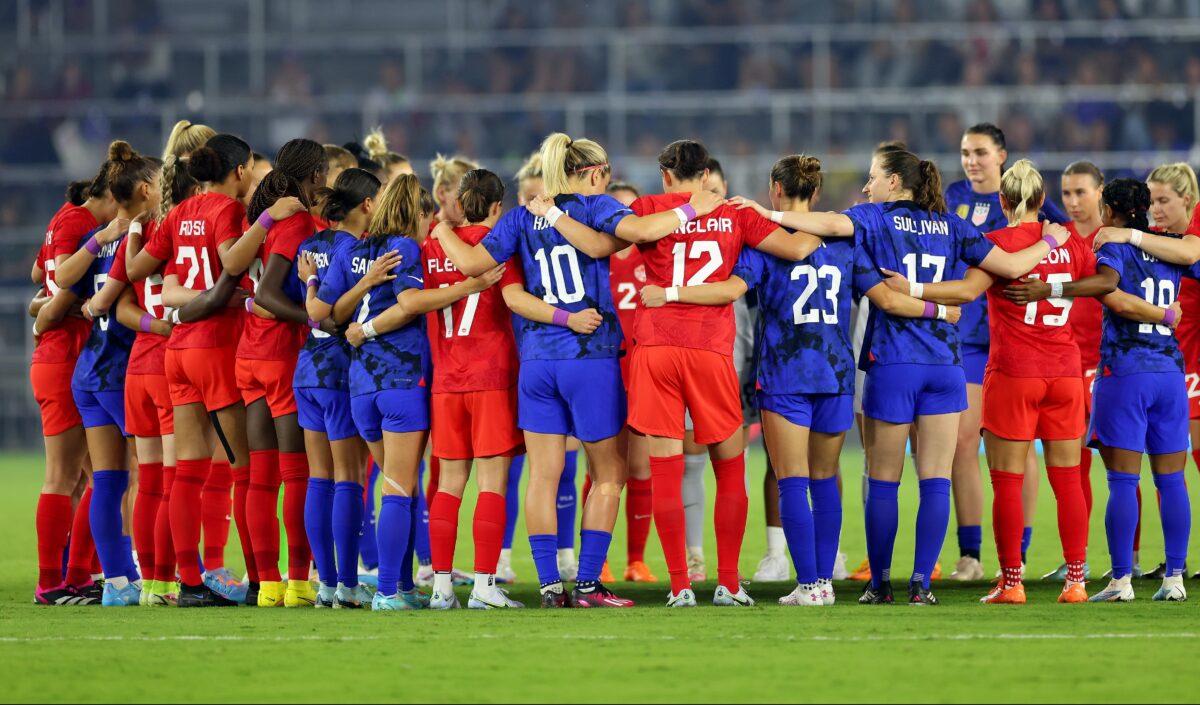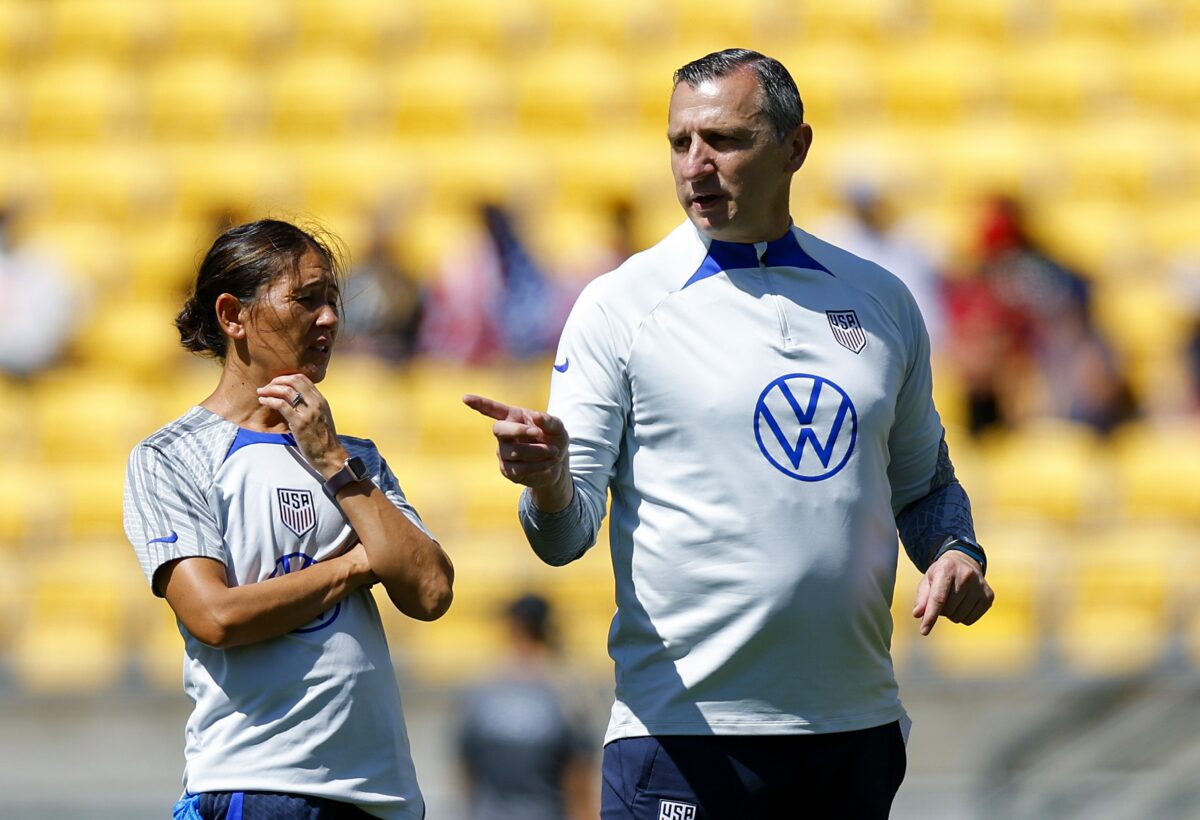At the moment, the U.S. women’s national team is a cliché glass of water.
If you see a team that has now won six straight games and just beat three strong sides in Canada, Japan, and Brazil en route to yet another SheBelieves Cup title, you’re looking at a half-full glass. They have a key player in extraordinary form, injured regulars are approaching full fitness, and they gave up just one goal in what is effectively a preseason tournament while facing sides whose players are in many cases closer to 100%.
If you’re thinking that Canada was a shadow of itself due to off-field issues with its federation, or that Japan worried the USWNT throughout their match, or are picturing Brazil’s near-misses from Kerolin or Adriana, you’re Team Half-Empty. You saw the USWNT struggle with two very different pressing set-ups, and are expecting things to go awry in the first game where the U.S. doesn’t bury their first great look at goal.
Well friends, guess what? You’re both making great points. Let’s get into the positives and negatives of the USWNT’s showing at the SheBelieves Cup.
Swanson’s show
Mallory Swanson is unstoppable at the moment, scoring in all three SheBelieves Cup matches for the USWNT and in seven straight games overall. The list of attacking players anywhere sharing this sort of stratospheric form consists of maybe Sam Kerr, and that’s it.
Under Vlatko Andonovski, there was a Christen Press phase before the pandemic like this, and Catarina Macario and Sophia Smith have spent time as the seemingly inevitable source of goals and assists on this team. Swanson is indisputably having her time under the spotlight right now.
One remarkable thing about this run is that it’s not happening with a particularly stable attacking group around her. The following is a list of what other attacking players were on the field when Swanson scored on this run:
- Morgan, Smith, Lavelle
- Morgan, Rodman, Lavelle
- Hatch, Rodman, Sanchez
- Morgan, Williams, Sanchez
- Morgan, Rodman, Sanchez
- Morgan, Williams, Lavelle
With Smith absent for both camps this year due to a foot injury, and Rose Lavelle missing two SheBelieves Cup games for precautionary reasons, Vlatko Andonovski has toggled between plenty of groups on offense, and Swanson seems to work just as well alongside any of them. We also saw Swanson look very comfortable playing off of Macario in 2021 and the early part of 2022, leaving little worry if the USWNT ends up going back to more of a false No. 9 look come the World Cup.
What’s been very impressive from Swanson is that she’s using her off-ball movement to create the kinds of chances she thrives in: running a channel, receiving the ball just as she breaks in behind the defense. Teams know the USWNT is looking for it. Right-sided defensive players know that’s where she’s going to end up, and still — whether in counter-pressing moments, long balls from the back, passes from midfield, or combination play — they can’t stop her from getting there anyway.
In the months ahead, any team that’s serious about winning the World Cup or that finds itself in Group E is going to be intently studying how to either prevent Swanson from finding these openings, or to cut off her supply from the rest of the group.
It’s vital for the USWNT that they keep opponents guessing, because at the moment, this doesn’t seem like a team that is going to imperiously march through seven games to a trophy. Much like these last two games in particular, the USWNT is on course for some very tight knockout round games in which one player being decisive is the difference.
The good news? The roster is deep with that kind of player, and Swanson in particular is arguably the decisive player in women’s soccer right now. If the team can maintain that — and especially if they add to it — their chances of a third straight World Cup victory are stronger than people seem to think right now.
Pressing problems
That said, there is a reason your social media timeline of choice seems full of doubt. It boils down to some clear issues the USWNT has had facing a high press. To be fair, any organized high press attempted by fast players is by its nature difficult to play through. To their credit, the USWNT has used friendlies to actually work on this rather than simply playing it safe in hopes of an exhibition victory.
However, it’s fair to say this is very much a work in progress, and come the World Cup, we may see them have to adopt some safety-first tactics to get through the opening stages of games. Generally speaking, that’s how high-pressing teams operate: you press for 15-20 minutes trying to get a lead or at least throw your opponent into disarray, then spend some time defending out of a more defined block so you don’t have a team full of exhausted players.
The USWNT, after simply overwhelming a Canada side that had been through so much coming into game one, found themselves on the other side of the coin against both Japan and Brazil. These games weren’t equal — Japan’s press was more organized and dangerous, whereas a tired-looking U.S. gave Brazil an assist by offering up some uncharacteristically sloppy play — but the outcome was close enough to the same that it should be a concern.

We’ve seen some other top teams unsettle the USWNT like this over the past few years. Sweden did it at the Olympics, and both Germany and Spain showed that they were paying attention to the trend late in 2022.
As was already covered here, to some extent any press that is executed at a reasonable level is going to make the team in possession look uncomfortable. There seems to be an expectation among fans that can’t be reconciled: many teams are improving worldwide and deserve more respect, but also, the USWNT should be able to beat anyone anywhere with ease, so that discomfort must be an indicator that the team is falling off a cliff.
The sky is not falling for the USWNT, who as a reminder just beat three higher-end teams despite fielding a squad that is (Lindsey Horan aside) in preseason. But it is time for the fanbase to come to grips with a reality that, as high-pressing tactics have become more and more a regular thing in the women’s game, USWNT games might look a little rough around the edges.
It also must be said that the USWNT showed its preseason status in these two games. Some fundamental elements — first touch, body shape when receiving the ball, how often they checked their shoulders, and how early they made their move to be an option for the next pass — were lacking. By contrast, Japan and Brazil both seemed to be closer to top gear. That shouldn’t be the case at the World Cup.
However, here’s where the worried USWNT fan might want to start looking when they consider issues with the team: in this tournament, both Japan and Brazil pressed the way you’d expect them to. Japan’s 3-4-2-1 is not an unknown quantity, and Pia Sundhage’s 4-4-2 with Brazil is something everyone should be very familiar with by now.
Why, then, did these pressing structures seem to come as such a surprise? It’s one thing to enter a game knowing that it’ll be a bit scruffy because both teams are pressing. It’s another to see the USWNT seemingly not prepared to find the angles needed to play around those differing shapes. Every press gives up openings to gain certain things, but the U.S. had to find those spaces rather than knowing where they would be from the jump.
Japan and Brazil both seemed to catch the USWNT off guard, and while the players and coaching staff both did solid work sorting things out on the fly, it’s a bit alarming that they were having to find their way mid-game, and that’s not a completely new issue. Last year’s three-game losing streak saw a similar dynamic play out.
The pressure right now on the coaching staff should be on making sure more games resemble the Canada match rather than a worrisome scramble to get through the first 20 minutes without conceding. Higher-end teams are no longer going to hold off on taking the big tactical risk pressing is against the USWNT, and as we saw last year, there are teams out there good enough to turn a worrying phase for the USWNT into actual goals.
Pressing solutions
The flip side to the USWNT’s issues when facing a press is that they remain an absolute nightmare of a counter-pressing team. That’s down to both the work of the coaching staff — Andonovski’s teams, going back to FC Kansas City and the former Seattle Reign, have largely been counter-pressing experts — and the individual players.
Swanson’s goal came from counter-pressure that ended with Lynn Williams forcing a turnover and getting the ball to Lavelle in space. The USWNT counter-pressed Brazil into a giveaway on Alex Morgan’s goal that wasn’t (a shame, since Andi Sullivan’s first-time through ball was the best pass either team played on Wednesday), and seized on another chaotic situation when Morgan scored a goal that actually counted a few moments later.
Williams is comfortably the best counter-pressing forward on the planet, and last month we were talking about how strong her claim is for a World Cup roster spot despite losing 2022 to injury. This is ultimately why the talk about her not being the most clinical finisher has always missed the point: the USWNT will score more goals with her in games, because they’ll get more chances, because no team and no individual is better at counter-pressing.
It’s not just Williams, though. Anyone who has watched Trinity Rodman in NWSL has seen her — even in mid-block systems, which the Washington Spirit have largely played during her first two seasons — force turnovers by combining a clear understanding of when to jump on an opposing player with her obvious athletic gifts. Rodman’s ability on that front already seems top-tier, and we’ve only really seen the tip of the iceberg. In Mark Parsons’ system this year — expect more high pressure and more counter-pressing — she’s going to improve rapidly.
Swanson and Smith may not force as many turnovers, but they’re both vital cogs in this machine due to how quickly they choose and make the correct run after the turnover comes. Going back to Swanson always managing to get stereotypical Swanson chances even though every opponent wants to prevent them, this is often where they come from. She (and Smith) see the turnover coming, and make the most dangerous run early. The USWNT player picking up the loose ball doesn’t have to cycle through options or take an extra touch to wait for the opening. The ball pops loose, and the pass in behind to a world-class attacker is already on.
Probably not a game that will be known for its attacking brilliance, but w/ USA only getting off 5 shots to Japan's 15, the chances that USA had *on average* were far better than the opponent.
— Arielle Dror (@arielle_dror) February 19, 2023
The Japan game was a perfect example. Japan’s expected goals were higher, as even a casual viewer would have guessed. However, since they also out-shot the USWNT by nine, their xG per shot was quite low. The USWNT didn’t create a lot, but the chances they carved out were good ones, and with their forwards, the higher xG chances tend to become actual goals.
All of this is to say that counter-pressing, and the avenue towards higher-leverage openings, is how the USWNT has been winning games that seem more even on a surface level. They put teams into terrible positions just when they believe they’ve dealt with the threat and start to open up their shape, and they have a range of forwards and midfielders (it must be mentioned that Lavelle is more or less an ideal No. 10 to receive the ball in a counter-pressing situation) built to thrive in exactly these moments.
More than any other thing, this is the path towards a USWNT World Cup win this summer.
[lawrence-related id=14470,14437,14439]
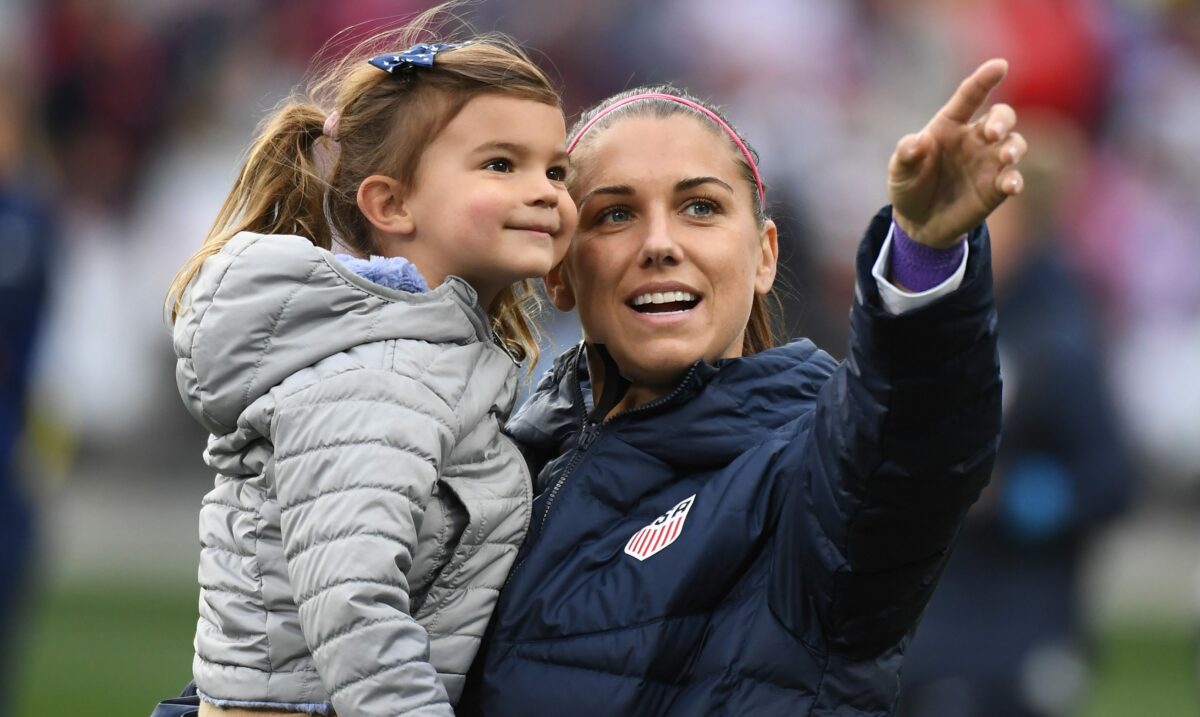

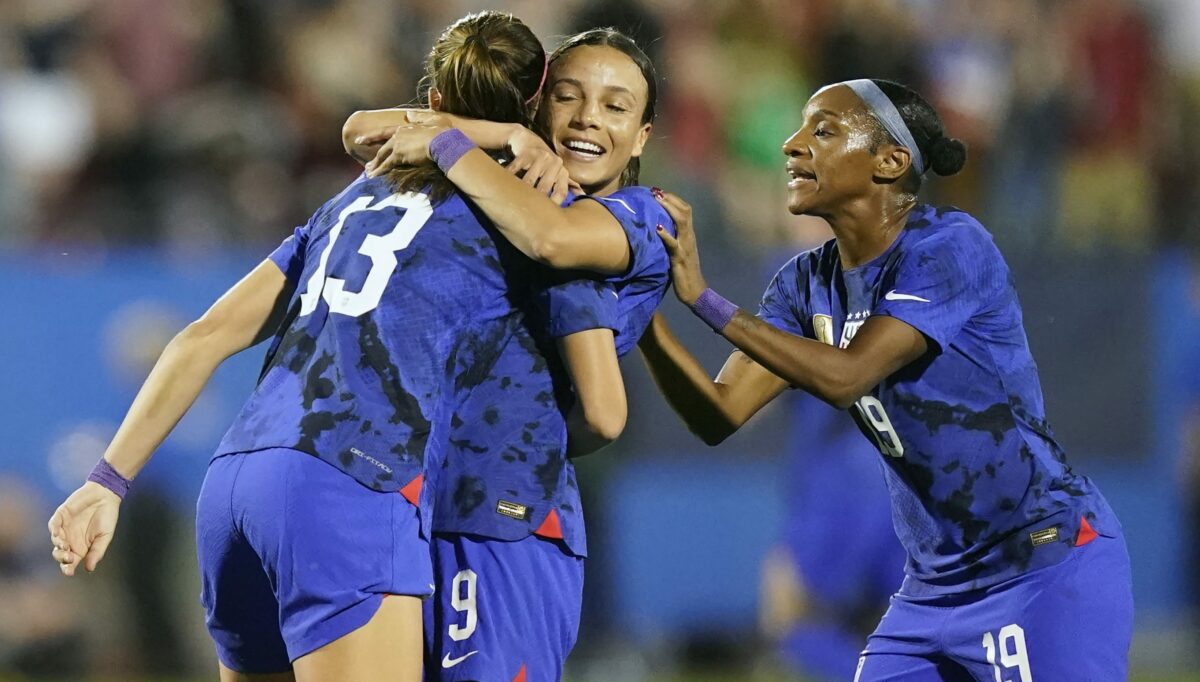
 :
: 

 Estados Unidos 2-1 Brasil
Estados Unidos 2-1 Brasil 

